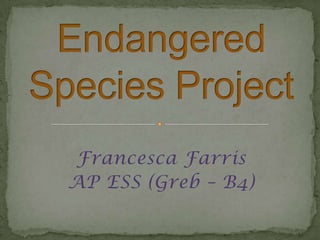
Endangered species project
- 1. Endangered Species Project Francesca Farris AP ESS (Greb – B4)
- 2. Alaotra Grebe (Tachybaptus rufolavatus) The Alaotra grebe is now extinct. These birds lived in Madagascar in only one lake, Lake Alaotra, a large, shallow lake.
- 3. Alaotra Grebe The Alaotra grebe ate mainly only fish. In 1982, twelve grebes were sighted at Lake Alaotra. In 1985, two were sighted. These were the last Alaotra grebes ever seen. In more recent visits to the area, no grebes were spotted. The species is now considered extinct. Gill-nets used by fishermen, exotic species that were introduced to the area by people, habitat degradation, poaching, hybridization with other species, and the grebes’ inability to fly long distances due to their small wings, are all factors that led to the demise of the Alaotra grebe.
- 4. Alaotra Grebe The loss of the Alaotra grebe is an aesthetic loss. These creatures, even if they did not serve a purpose to humans, still did not deserve to die at our hands. The loss of this species and many other recent losses is only helping to prove that the world is currently in the 6th mass extinction, the Holocene era extinction. Organizations like BirdLife International are working to ensure that extinctions like this don’t occur anymore. Close surveillance and breeding programs are two ways that they are trying to keep endangered species alive.
- 5. “Little Bird Gone”, by Nancy Patterson
- 6. Black Rhinoceros (Diceros bicornis) The black rhinoceros is critically endangered.These rhinos live in Africa, mainly on wildlife preserves to ensure their safety. They can be found in the Namibian deserts, wooded grasslands, the broadleaved woodlands, and the savannah.
- 7. Black Rhinoceros The black rhino feeds mainly on leaves, twigs, and other vegetation. The demand for their horns is the main reason for the black rhino’s decimation. In Yemen and other places, the rhino’s horns are used as dagger handles. They are also used in traditional Chinese medicine. Around 96% of the black rhino’s population was lost between 1970 and 1992. This occurred because of the increased incomes of oil-rich Gulf states that wanted the rhino’s horns.
- 8. Black Rhinoceros The loss of the black rhinoceros will be an aesthetic loss. These animals should not have to die out simply because of human greed. Organizations like the following have been working hard to make sure the black rhinoceros does not go extinct: ~Convention on International Trade in Endangered Species (CITES) ~African Rhino Specialist Group of the World Conservation Union (IUCN) Efforts by these groups to protect the rhinos by putting them on nature preserves, as well as dehorning the rhinos to decrease poaching, are helping to increase the numbers of black rhinos alive today. The population of black rhinos, which was around 2,400 in the latter part of the 20th century, has since been increased to 3,100 rhinos since 2001.
- 9. Black-footed Ferret (Mustela nigripes) The black-footed ferret is an endangered species that, due to human efforts, is making a comeback. These ferrets were once found all the way from Canada to the southwestern United States (they are the only species of ferret native to North America). In 1979, the species was given up for extinct. However, a small population was found and used for breeding and artificial insemination programs to bring them back.
- 10. Black-footed Ferret The black-footed ferrets’ diet consists mainly of prairie dogs and other small mammals. Habitat loss, due to agricultural use of prairies, a government-sponsored eradication program used in the mid-1900s to poison and kill prairie dogs (the ferrets’ main food source), and canine distemper and plague, diseases that killed many of the ferrets, are the main reasons for the loss of many of the members of this species. In the mid-1980s, eighteen ferrets were caught and bred, as well as artificially inseminated, effectively raising the nearly-extinct species’ population to around 5,000 by 2010. The ferrets have been introduced to eighteen sites, with 1,500 having been released in the wild and up to 250 having been born in the wild. Due to human efforts, this species has moved from being extinct in the wild to endangered. Three self-sustaining populations of the ferrets exist in North America today.
- 11. Black-footed Ferret The black-footed ferret is a natural way to keep the prairie dog population from becoming too high. If the prairie dog, a keystone species, becomes too large in population, the populations of the species that feed on it may increase too dramatically, and the populations of the species that the prairie dog feeds on may decrease too dramatically. Organizations like the following have been working hard to make sure the black-footed ferret does not go extinct: ~The American Zoo and Aquarium Association are the ones responsible for the action plan made to increase the population of black-footed ferrets.
- 12. Works Cited "7 Endangered Species Making a Comeback." EcoSalon. EcoSalon.com, 2010. Web. 20 Jan. 2011. <http://ecosalon.com/7_endangered_species_making_a_comeback/>. Long, Ade. "Alaotra Grebe Extinction – Do You Care?" The BirdLife Community. BirdLife International, 26 May 2010. Web. 22 Jan. 2011. <http://www.birdlife.org/community/2010/05/alaotra-grebe-extinction-do-you-care/>. "Alaotra Grebe (Tachybaptus rufolavatus)." ARKive: Images of Life on Earth. Environment Agency - Abu Dhabi, 2010. Web. 22 Jan. 2011. <http://www.arkive.org/alaotra-grebe/tachybaptus-rufolavatus/#src=portletV3api>.
- 13. Works Cited Cont’d "Black-footed Ferret (Mustela nigripes)." ARKive: Images of Life on Earth. Environment Agency - Abu Dhabi, 2010. Web. 20 Jan. 2011. <http://www.arkive.org/black-footed-ferret/mustela-nigripes/>. "Black Rhinoceros (Diceros bicornis)." ARKive: Images of Life on Earth. Environment Agency - Abu Dhabi, 2010. Web. 20 Jan. 2011. <http://www.arkive.org/black-rhinoceros/diceros-bicornis/#text=Facts>. Patterson, Nancy. "Little Bird Gone." (26 May 2010). 23 Jan. 2011.
- 14. Works Cited Cont’d "Tachybaptus rufolavatus." The IUCN Red List of Threatened Species. International Union for Conservation of Nature and Natural Resources, 2010. Web. 20 Jan. 2011. <http://www.iucnredlist.org/apps/redlist/details/144589/0>. Trivedi, Bijal P. "Black-Footed Ferrets Making a Comeback Through Artificial Insemination." National Geographic. National Geographic Society, 11 July 2002. Web. 20 Jan. 2011. <http://news.nationalgeographic.com/news/2002/07/0710_020710_TVferret.html>.